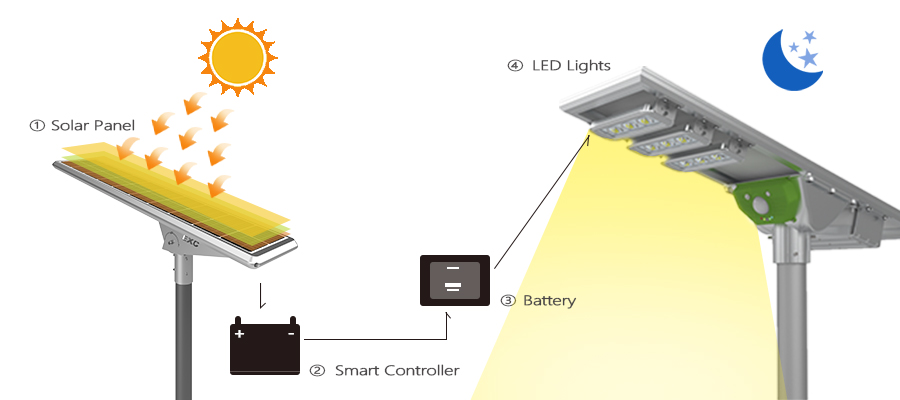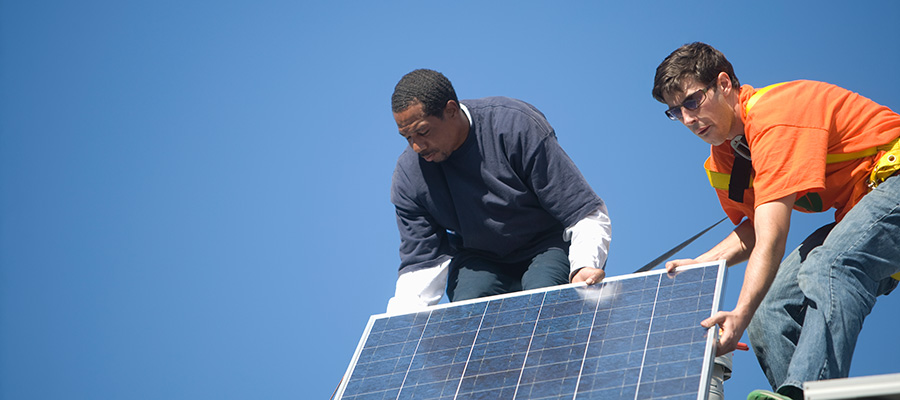How does the Solar Panel of Solar Energy Street Light Work?
2021-06-25
VIEW "2335
Solar panels, also known as "solar chips" or "photocells" and "solar cells", are photoelectric semiconductor sheets that use solar light to directly generate electricity. A device that directly converts solar light energy into electrical energy through the photoelectric effect or photochemical effect. In physics, it is called photovoltaic (Photovoltaic, abbreviated as PV), or photovoltaic for short. Single solar cells can’t be used directly as power sources. To use as a power source, several single solar cells must be connected in series and parallel and tightly sealed into components. Its working principle is simply that the solar panels absorb solar light energy during the day and convert it into electrical energy and store it in the battery, and the battery powers the solar energy street light at night. So why do solar panels produce electricity in sunny conditions?

Solar panels generally use devices that respond to light and can convert solar light energy into electricity. The most common material is silicon, which is one of the most abundant materials on the earth. It has semiconductor characteristics, which lays the foundation for the photoelectric conversion process of solar panels.
But the first thing to understand is that the conductivity of pure silicon is very poor, and there are no electrons that can move freely in the crystal structure. To enhance its conductivity, pure silicon is usually doped with trace impurities to enhance its conductivity. According to this characteristic, different conductive devices can be made.

For the silicon used to make
solar panels of solar energy street light, phosphorus or boron is usually added. When boron is added, the silicon crystal will form a hole. Because the original silicon atom is surrounded by 4 electrons, and the boron atom is surrounded by only 3 electrons, holes will also be generated when it is doped into the original crystal structure. Without electrons, this hole is very unstable and easily absorbs other electrons to form a P-type semiconductor.
When phosphorus impurities are doped into silicon crystals, because there are 5 electrons around the phosphorus atoms, the extra electron will be very active, forming an N-type semiconductor. There are many holes in P-type semiconductors, and there are many active free electrons in N-type semiconductors. When the two contacts, these free electrons will find holes and fill them. The contact surface between the two will form a potential difference, that is, a PN junction. The P-type side is positively and negatively charged, and the N-type side is positively charged.
When light is received, the energy contained in the light will be transferred to the semiconductor. This energy will loosen the structure of the electrons and move freely. This is because solar light energy will take apart electrons and holes. Under normal circumstances, a photon with a certain energy will release an electron, which just happens to form a free hole. If this happens just near the contact surface, and when attracted by the built-in electric field, electrons will flow into the n zone, and holes will flow into the P zone, forming a current from the N-type zone to the P-type zone. The power plant of the battery is formed. Electricity is formed by voltage, which is used for charging.
However, it should be noted that semiconductors are not good conductors of electricity, and electrons flow through the P-N junction and then flow in the semiconductor, which will cause a lot of loss. Therefore, the upper layer is usually coated with metal. However, if it is fully painted, it will cause sunlight to fail to pass. Under normal circumstances, a metal grid is used to cover the P-N junction. Another thing to note is that the surface of silicon is highly reflective. If it is not treated, a large amount of sunlight will be reflected. To solve this problem, the solar energy street light manufacturer will usually add a layer of protective film of low reflection coefficient on the solar panel. The loss caused by reflection will be controlled within 5%.

